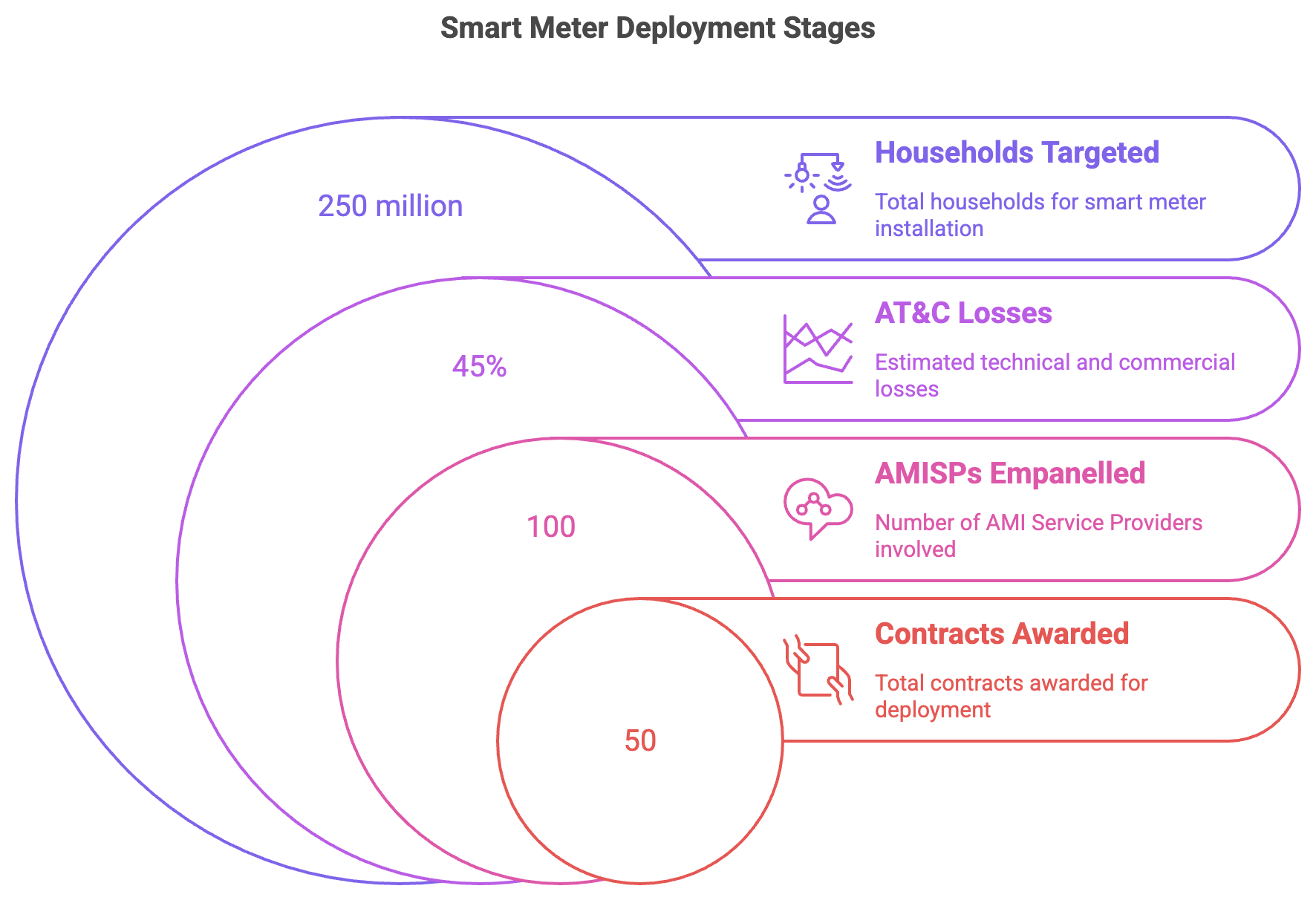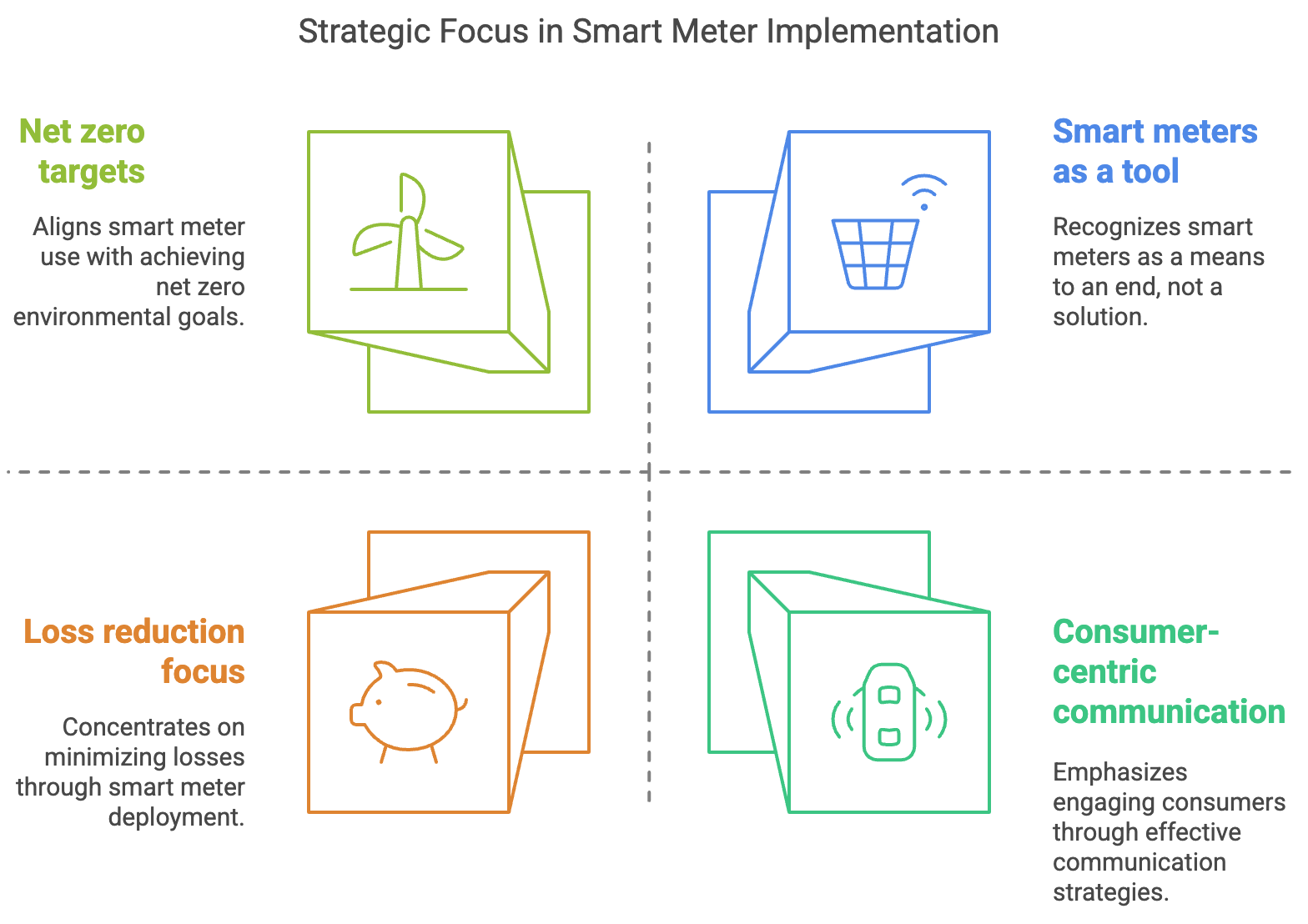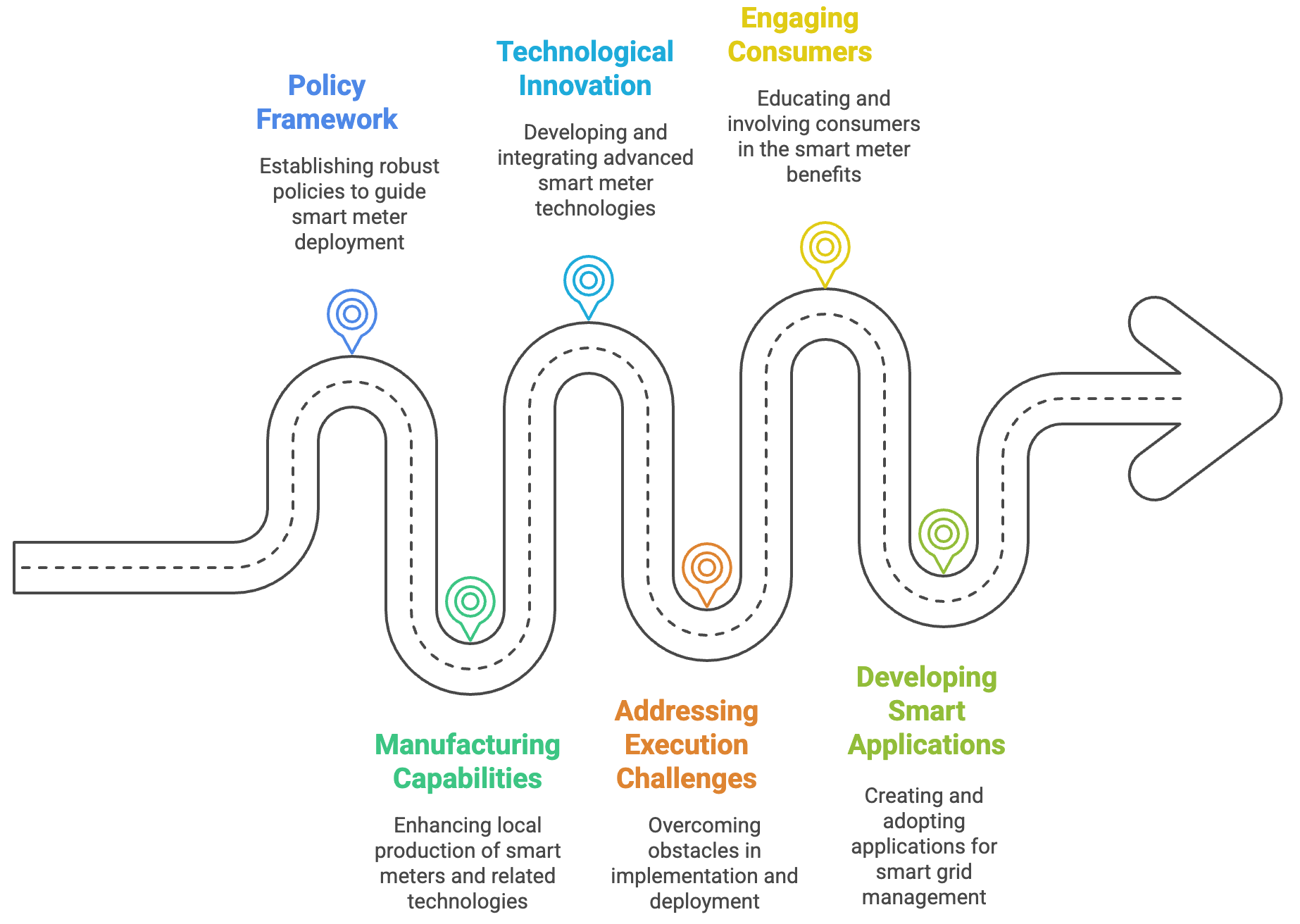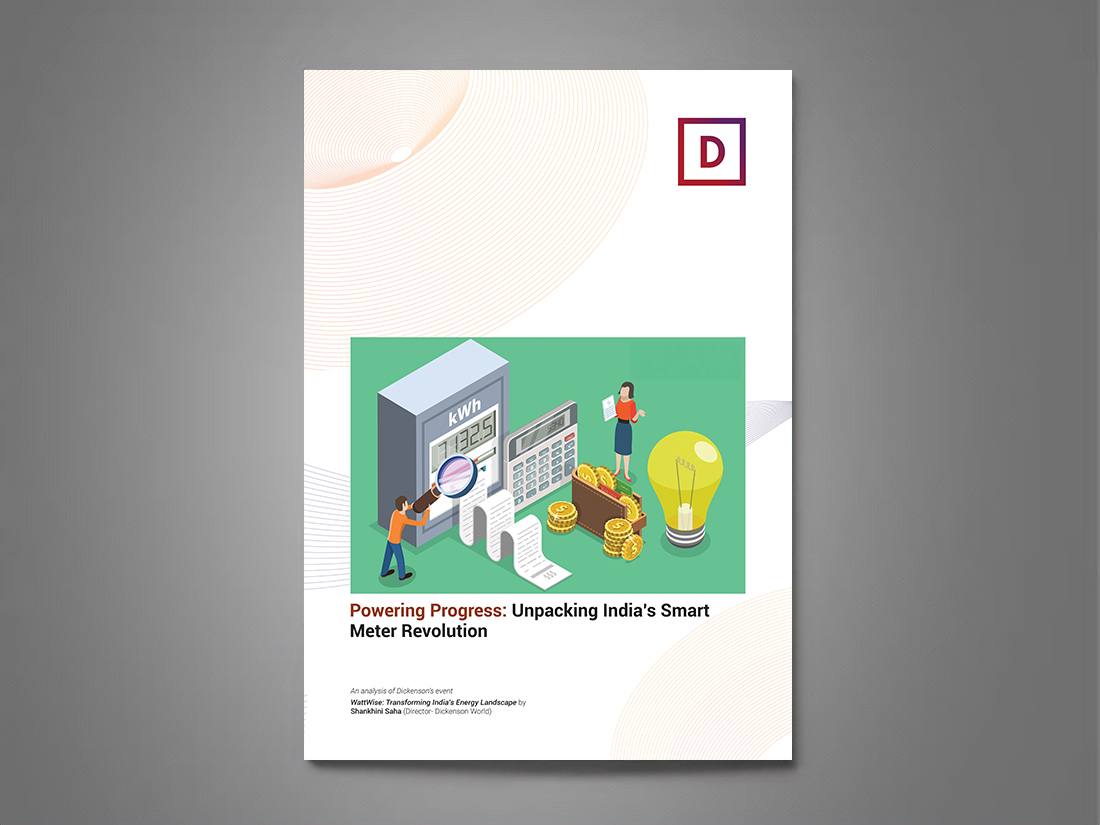Powering Progress:
Unpacking India’s Smart Meter Revolution
An analysis of Dickenson’s event WattWise: Transforming India’s Energy Landscape by Shankhini Saha (Director- Dickenson)
Excerpt: Key Insights from India’s Smart Meter Webinar
India’s ambitious smart meter deployment under the RDSS scheme is more than just a meter replacement program; it’s a pivotal step towards a smarter and more efficient energy future. A recent webinar highlighted the key challenges and opportunities in this transformative journey.
Introduction
India stands at the cusp of a significant transformation in its energy landscape, driven by the ambitious goal of deploying 250 million smart meters under the Revamped Distribution Sector Scheme (RDSS).
A recent webinar, “WattWise: Transforming India’s Energy Landscape with Smart Meters,” presented by Dickenson World, brought together key stakeholders – manufacturers, component suppliers, a former regulator, and industry leaders – to dissect the challenges, innovations, and strategic pathways of this monumental undertaking. This thought-provoking forum illuminated the complexities and the immense potential of this transition, offering invaluable insights into the future of India’s power sector.
Speakers:
-
Mr. Manish C. Swamie (Head of Marketing & Sales: Utility Business- HPL Electric & Power Ltd.)
-
Mr. Ankit Agarwal (CEO & Whole-time Director of RMC Switchgears Ltd.)
-
Mr. Kabir Ghumman & Mr. N.S. Ghumman (Managing Director & Chairman of Shivalik Bimetal Controls Ltd.)
-
Mr. Rajesh Bansal (Ex-CEO of BRPL)
The Ambitious Scope and the Role of AMISPs
The scale of the RDSS scheme is staggering, aiming to replace existing meters in 25 crore (250 million) households with smart meters. Shankhini Saha, Director at Dickenson World and moderator of the event, set the stage by emphasizing the industry and technology focus of the discussion, steering clear of company-specific performances.
Manish C. Swami, Head of Marketing Sales and Utility at HPL Electric and Power Limited, a leading smart meter manufacturer, highlighted the rationale behind this massive deployment. He pointed to the significant aggregated technical and commercial (AT&C) losses in the Indian power distribution sector, estimated at 40-45%. The deployment of smart meters under the Advanced Metering Infrastructure (AMI) is envisioned as a critical step to bring these losses down to single digits.
Swami explained that the AMI ecosystem comprises three key components: smart meters, communication networks, and IT infrastructure (head-end systems, data management). The Government of India, through REC Limited as the nodal agency, is driving this initiative via RDSS tenders. AMISPs (AMI Service Providers) get empanelled, often using meters from manufacturers like HPL , and then bid for these tenders based on an L1 (lowest bidder) criteria. These contracts operate on an opex model, with AMISPs receiving initial advances and subsequent payments based on per-meter data reading .

Manufacturing Might and the "Make in India" Imperative
HPL Electric emphasizes backward integration, manufacturing plastic parts, PCBs, and communication network cards in-house. This strategy aims to reduce dependency on external suppliers and maintain quality control. Swami proudly noted HPL's early entry into smart meter development, with their first set produced in 2012 , and their current manufacturing capacity of around 1 to 1.5 crore (10-15 million) smart meters per annum.
Aligning with the government's "Make in India" initiative, HPL has collaborations like the one with Guangxi Ramway for in-house relay switch manufacturing. They have also partnered with Wirepas to develop an in-meter gateway unit, further indigenizing the technology . Swami stressed HPL's strong R&D team, continuously developing new products and features beyond the RDSS requirements.
Ensuring Reliability: The Critical Role of Enclosures
Ankit Agarwal, CEO and Wholetime Director of RMC Switchgears Limited, focused on the crucial role of durable and tamper-proof enclosures for smart meters, especially given India's diverse climatic and infrastructural conditions. RMC, with 29 years of experience in electrical enclosure manufacturing, customizes enclosures to meet specific state and utility requirements while prioritizing electrocution-free and theft-free environments.
Agarwal highlighted the importance of compliance and certifications, adhering to BIS and IEC standards, as metering is a revenue-generating product with safety being paramount. RMC is proud to be among the first BIS-approved laboratories for metering enclosures.
Addressing the utility's need for cost-effective yet reliable solutions, Agarwal discussed the optimization of material inputs, particularly the shift towards Sheet Moulding Compound (SMC) and Fiber Reinforced Polymer (FRP) enclosures over metal and polycarbonate, especially for AMISP projects where network issues with metal are a concern. These composite materials offer mechanical strength, thermal resistance, chemical resistance, and meet electrical requirements, with a focus on a 15-20 year lifespan, exceeding the 10-year RDSS requirement . RMC is also exploring sustainable and recyclable polymer composites.
Precision at the Core: The Importance of Shunt Resistors
The accuracy and efficiency of smart meters hinge on precision components like shunt resistors. NS Ghumman, Chairman, and Kabir Ghumman, Managing Director, of Shivalik Bimetal Controls Limited, delved into the critical role these components play. Kabir explained that a shunt resistor measures the voltage drop across it, which is proportional to the current flow. The accuracy of the shunt resistor is therefore paramount for precise current sensing, and any power loss due to design or materials can lead to errors.
Shivalik differentiates itself through its expertise in electron beam welding, a highly controlled process under vacuum that fuses copper terminals with a specific resistance alloy, minimizing contamination and defects. Their focus on selecting and qualifying the best possible materials, with continuous R&D and stringent testing (often meeting even higher automotive standards), ensures reliability and long-term stability.
While anticipating a massive demand for components, Kabir Ghumman assured that Shivalik has diversified raw material sourcing and possesses the world's highest capacity in continuous strip electron beam welding to meet the volume requirements. Downstream processes can be scaled up as needed . He noted a growing global demand for shunt-based current sensing, indicating the technology's staying power.
Navigating the Regulatory Landscape and Consumer Concerns
Rajesh Bansal, former CEO of BRPL, brought a critical regulatory perspective to the discussion. He emphasized that while installing 100% smart meters might seem like the mission, it is merely the first step . He argued that smart meters are a tool, not a solution, and the true mission should revolve around net zero targets, consumer enrichment and engagement, and efficient utility operations.
Bansal cautioned against solely focusing on loss reduction, highlighting that smart meters globally have been adopted for broader reasons, including grid management with increasing renewable energy and electric vehicle penetration . He stressed the need for consumer-centric communication, focusing on benefits like reduced accidents through alerts on faulty wiring, energy conservation insights, and convenient prepaid options with potential discounts, rather than solely emphasizing disconnection for non-payment.
He raised critical questions about the implementation of prepaid metering, particularly concerning the deduction of penalties and charges, and the need for clear processes to avoid consumer unrest. Bansal also highlighted the importance of regulatory foresight in anticipating the benefits and potential drawbacks of smart meter deployment, suggesting tariff adjustments based on realized gains . He pointed out that the RDSS standard bid document is excellent but needs review based on the implementation experience.
Synergies and the Path Forward: Collaboration is Key
The final panel discussion addressed coordination challenges between meter and enclosure manufacturers. Ankit Agarwal clarified that there isn't a demand-supply mismatch, but rather a challenge in the pace of execution at the ground level, often due to consumer resistance and political factors. Manish Swami, with HPL's backward integration, echoed this, stating they don't foresee coordination issues.
The discussion then shifted to the crucial aspect of applications and leveraging the "smartness" of smart meters. Rajesh Bansal emphasized the gap between the hardware capabilities and the availability of smart applications that truly benefit consumers and utilities. Manish Swami highlighted HPL's early experience with mobile apps for prepaid meters in Telangana back in 2015-16, providing consumers with usage data and payment convenience . He noted the integration of HPL's meters with over 20 head-end systems, enabling communication through various apps for energy conservation education and seamless bill payments. Bansal suggested India could become a hub for smart meter applications, leveraging its IT prowess and diverse utility landscape .
The role of Artificial Intelligence (AI) was also briefly touched upon. While HPL indicated it's a technical matter for their team to elaborate, Kabir Ghumman explained Shivalik's focus on AI in end-of-line inspection, using optical data to detect anomalies and predict potential production defects, ensuring high quality and accuracy.
Finally, the panel considered the nuances of urban versus rural deployment. Rajesh Bansal and Manish Swami agreed that while consumer profiles and electricity consumption habits differ, the current meter specifications are balanced and suitable for both contexts. The primary differentiation lies in the choice of communication network, with RF often preferred for urban areas and cellular communication for scattered rural regions .

Conclusion: A Collaborative Journey Towards a Smarter Grid
The webinar provided a comprehensive overview of India's smart meter deployment journey. While significant progress has been made in terms of policy framework, manufacturing capabilities, and technological innovation, the key to realizing the full potential of this initiative lies in addressing execution challenges, effectively engaging consumers by communicating tangible benefits, and fostering the development and adoption of smart applications. Collaboration between all stakeholders, policymakers, regulators, utilities, manufacturers, and consumers, will be crucial in navigating the hurdles and paving the way for a truly transformed and efficient energy landscape in India.

Contact Us: To learn more or schedule a consultation, please reach out to us at www.dickensonworld.com
Email:enquiry@dickensonworld.com.

About the Author
Shankhini Saha, the Director of Investor Relations at Dickenson, holds an MPhil with distinction from the University of Cambridge, UK, and a BA magna cum laude from The New School, USA. Specializing in stakeholder engagement across diverse sectors, Shankhini is dedicated to transparent communication and providing strategic insights into clients’ financial performance and growth initiatives. With a proven track record of managing complex investor relations for a diverse portfolio of global clients, she excels in crafting impactful narratives that resonate with investors, analysts, and stakeholders. Shankhini’s leadership in high-profile quarterly results hosting and comprehensive IR campaigns showcases her commitment to creating lasting value for issuers in the global capital market.

Powering Progress: Unpacking India’s Smart Meter Revolution
To download and save this article.
Authored by:
Shankhini Saha
Director, Dickenson World
Visit www.dickensonworld.com to learn more about our services and how we can help streamline your corporate reporting process.






Leave A Comment